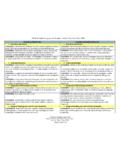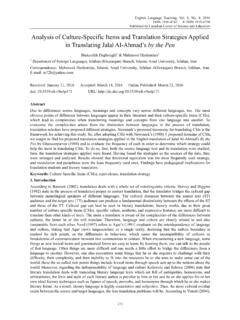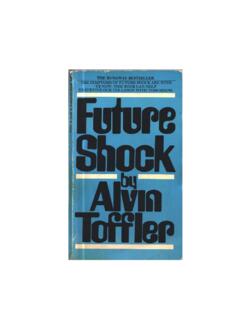Transcription of Essentials of Thematic Analysis
1 VSeries Foreword Clara E. Hill and Sarah Knox Foundations of Thematic Analysis3A Flexible Analytical Method5 Will the Real TA Please Stand Up?9 Constructed Themes as the Product of Reflexive Design and Data Generation15 Research Team Considerations15 Research Questions17 Methods of Generating Data18 Determining Sample Analysis : Familiarization and Coding29 Phase 1: Familiarization30 Phase 2: Analysis : Theme Construction and Development43 Phase 3: Initial Theme Generation43 Phase 4: Developing and Reviewing Themes55 Phase 5: Naming and Defining Your Research and Writing the Results65 Writing Your Introduction66 Writing the Method for TA66 Writing the Results Section71 ContentsCOPYRIGHT AMERICAN PSYCHOLOGICAL ASSOCIATIONvi Contents6. Variations on the Method 77 Variations on TA (the Other Schools of TA) 78 Variations of Reflexive TA 797. Summary and Conclusions 85 Appendix: Exemplar Studies 89 References 91 Index 99 About the Authors 105 About the Series Editors 107 COPYRIGHT AMERICAN PSYCHOLOGICAL ASSOCIATIONviiSeries ForewordQualitative approaches have become accepted and indeed embraced as empirical methods within the social sciences, as scholars have realized that many of the phenomena in which we are interested are complex and require deep inner reflection and equally penetrating examination.
2 Quantitative approaches often cannot capture such phenomena well through their stan-dard methods ( , self-report measures), so qualitative designs using inter-views and other in-depth data-gathering procedures offer exciting, nimble, and useful research , the number and variety of qualitative approaches that have been developed is remarkable. We remember Bill Stiles saying (quoting Chairman Mao) at one meeting about methods, Let a hundred flowers bloom, indicating that there are many appropriate methods for addressing research questions. In this series, we celebrate this diversity (hence, the cover design of flowers).The question for many of us, though, has been how to decide among approaches and how to learn the different methods. Many prior descriptions of the various qualitative methods have not provided clear enough descriptions of the methods, making it difficult for novice researchers to learn how to use them.
3 Thus, those interested in learning about and pursuing qualitative research need crisp and thorough descriptions of these approaches, with lots of examples to illustrate the method, so that readers can grasp how to use the purpose of this series of books, then, is to present a range of qualitative approaches that seemed most exciting and illustrative of the range of methods COPYRIGHT AMERICAN PSYCHOLOGICAL ASSOCIATION viii Series Forewordappropriate for social science research. We asked leading experts in qualita-tive methods to contribute to the series, and to our delight, they accepted our invitations. Through this series, readers have the opportunity to learn quali-tative research methods from those who developed the methods and/or who have been using them successfully for asked the authors of each book to provide context for the method, including a rationale, situating the method within the qualitative tradition, describing the method s philosophical and epistemological background, and noting the key features of the method.
4 We then asked them to describe in detail the steps of the method, including the research team, sampling, biases and expectations, data collection, data Analysis , and variations on the method. We also asked authors to provide tips for the research process and for writing a manuscript emerging from a study that used the method. Finally, we asked authors to reflect on the methodological integrity of the approach, along with the benefits and limitations of the particular series of books can be used in several different ways. Instructors teaching courses in qualitative research could use the whole series, presenting one method at a time to expose students to a range of qualitative methods. Alternatively, instructors could choose to focus on just a few approaches, as depicted in specific books, supplementing the books with examples from studies that have been published using the approaches, and providing experiential exercises to help students get started using the approaches.
5 Other researchers will just use one book as they strive to master one qualita-tive and Hayfield s book on a reflexive approach to Thematic Analysis provides a clear description of how to construct situated truth from qualita-tive data. The authors emphasize that this approach is a method ( , a flexible tool to fit the needs of a specific project) rather than a methodology ( , including a theoretical framework). They celebrate the idea of flexibility, subjectivity, and going beyond mere summaries of the data to deep under-standings of the underlying structures. The method requires extensive engage-ment with the data and consistent efforts to check and think about analytic understandings. The book is designed for both beginners and experts, bringing the method to life with extensive tips, figures, and exhibits. Clara E. Hill and Sarah KnoxCOPYRIGHT AMERICAN PSYCHOLOGICAL ASSOCIATION31 Over the last decade, Thematic Analysis (TA) has become an increasingly popular way of engaging with qualitative data.
6 TA is highly cited as an ana-lytic method of choice for many, not only within psychology but also across a wide range of disciplines (Joffe, 2012; Terry et al., 2017). Researchers posi-tioned within most theoretical frameworks can use TA to do justice to the piles of interview or focus group transcripts, qualitative survey responses, or other qualitative data they have generated. TA is a flexible analytical method that enables the researcher to construct themes meaning-based patterns to report their interpretation of a qualitative data set. It has proven utility for novice and experienced researchers alike, as can be seen in the vast numbers of theses, dissertations, papers, and reports that cite one version of TA or another as their primary analytic method. Among those who have been con-vinced of its merits, it is viewed as a rigorous, powerful, and yet straight-forward way of engaging with qualitative the newness of the method s explosion in use, versions of TA have been around a long time.
7 These versions were often just not described as TA at all, were poorly described, or were aligned with particular methodolo-gies and thus already wedded to a theoretical framework. Consequently, over CONCEPTUAL FOUNDATIONS OF Thematic of Thematic Analysis , by G. Terry and N. HayfieldCopyright 2021 by the American Psychological Association. All rights AMERICAN PSYCHOLOGICAL ASSOCIATION4 Essentials of Thematic Analysis15 years ago, Braun and Clarke (2006) argued that TA was taken for granted, commonly deployed, and yet poorly described and delineated. The landscape has changed, though. Braun and Clarke s 2006 paper has now been cited many thousands of times on Google Scholar, and alongside other writing about TA, there is a now a developing corpus of work that helps clarify the various ways TA can be used and understood ( , Braun & Clarke, 2012, 2019a; Braun et al.)
8 , 2015, 2018, 2019; Clarke et al., 2015; Terry & Hayfield, 2020; Terry et al., 2017).What has become clear through the work of Braun, Clarke, and their colleagues is that there is more than one expression of TA, something we discuss in more detail later in this chapter and in Chapter 6. Although Braun and Clarke s (2006) seminal paper is popular, it speaks about a particular type of TA what they have since referred to as reflexive TA (Braun & Clarke, 2019a; Braun et al., 2018, 2019). Central to reflexive TA is the idea of reflexivity, or the importance of the researcher s interpretation of the data. Within reflexive TA, Analysis occurs because of, rather than despite, the researcher s subjectivity their values, backgrounds, decisions, and interests. In contrast to methods that attempt to create objective distance because of concerns about bias, reflexive TA is premised on the engagement of the researcher with their data, guided by their research question and theoretical orientations.
9 In this text, we aim to contribute to increasing clarity regarding the shape and utility of reflexive TA more generally is no longer poorly demarcated (Braun & Clarke, 2006, p. 77), there is still work needed to ensure that the use of reflexive TA, and its ongoing evolution, continue to reflect its fundamental core values: (a) theoretical flexibility; (b) procedural focus on a systematic, ever-increasing, and rigorous engagement with data; (c) emphasis on the reflexive contribution of the researcher; and (d) framing of themes as multi-faceted, conceptual, meaning-based patterns. We keep returning to these core values throughout this book because they are central to the doing of reflexive TA. However, along with Virginia Braun and Victoria Clarke, we do not view this method as strictly following a recipe or a set of rules (Braun et al.)
10 , 2019). Reflexive TA is simply one way of thematizing qualitative data that we think has considerable value in the wider qualitative research draw on almost 30 years of combined experience to help shape this text and its focus. We were both students of Virginia Braun (Gareth) and Victoria Clarke (Nikki), directly benefiting from their input into our work and, more recently, collaborating with them on writing about reflexive TA. We have both worked extensively to support people using TA, teaching the approach through workshops, formal lectures, tutoring, one-to-one problem solving, and informal conversations. We have used it in our published work COPYRIGHT AMERICAN PSYCHOLOGICAL ASSOCIATIONC onceptual Foundations of Thematic Analysis 5and supported others use of it in theirs. We hope that this text acts to supple-ment this ongoing support of people who are interested in TA particularly its reflexive expression.

















